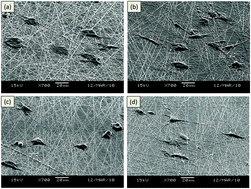Fabrication of keratin/fibroin membranes by electrospinning for vascular tissue engineering†
Abstract
Cardiovascular diseases (CVDs) are some of the leading causes of death and bypass surgery is one of the common treatment options for the critical CVD patients. There is no ideal material available for arterial bypass surgery. Herein, a fibroin and keratin porous membrane was prepared by electro-spinning and proposed for tissue-engineered vascular grafts (TEVGs). The purified fibroin (F) and keratin (K) were mixed in different weight ratios of 9 : 1 (FK91), 8 : 2 (FK82), and 7 : 3 (FK73) to obtain a membrane. The SEM images revealed that the electro-spinned membranes have a fibrous interconnected porous structure. The average diameter of the membrane F, FK91, FK82 and FK73 was 5.74 ± 1.04, 4.20 ± 1.19, 2.94 ± 0.81 and 2.27 ± 0.65 μm, respectively. The ultimate tensile strength (UTS) of F, FK91, FK82 and FK73 was 2.09 ± 0.06, 2.02 ± 0.06, 1.81 ± 0.10 and 1.74 ± 0.12 MPa, respectively. The contact angle of F, FK91, FK82 and FK73 was 72.55 ± 0.55°, 66.39 ± 0.90°, 43.47 ± 0.04° and 33.65 ± 2.83°, respectively. The wettability results were in agreement with those of the cell adhesion to the electro-spinning membranes. The attached HUVECs on the developed membranes showed no cytotoxicity. The immunocytochemistry staining and qPCR analysis showed that the phenotype of the keratin-fibroin membrane was not altered. The results of the ultimate tensile strength, cell adhesion and microstructure revealed that FK82 is similar to native vessels and could be considered as a potential material for TEVGs.


 Please wait while we load your content...
Please wait while we load your content...